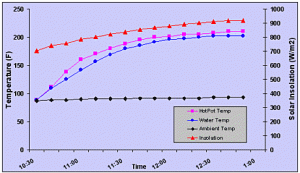
Field Tests of the HotPot, a New Solar Cooker, in West Africa
According to the World Bank, 94% of the African rural population and 73% of the urban population use fuelwood as their primary energy source. Unfortunately, supplies of fuelwood are diminishing throughout the world. As the cost and collection time for fuelwood increases, people are looking for alternative energy sources.
In many sunny parts of the world, solar cooking is a viable option. The HotPot is a newly developed solar cooker, which was adapted by the Florida Solar Energy Center and by Energy Laboratories, Inc. from designs of a panel oven by Dr. Roger Bernard and Solar Cookers International. This durable, affordable, and portable solar cooker is easier to use, store, and maintain than many other solar cookers. This study will show that the level of the HotPot performance makes it an ideal solar cooker for citizens worldwide.
The following tests were conducted on the HotPot in the field in several West African countries, including Burkina Faso, The Gambia, and Senegal:
- The Stagnation Test
This test determines the maximum temperature reached by an empty solar cooker. Measurements of the temperature inside the HotPot, the ambient temperature, and solar insolation are recorded every 10 minutes until a maximum temperature is attained. - The Water Heating Test
This test evaluates the thermal performance of the solar cooker in heating water to 90°C (194°F). This is the temperature where a slow boil can be observed. One liter of water was placed in the HotPot and brought to a boil. Measurements of the water temperature, the temperature inside the HotPot, the ambient temperature, and solar insolation are recorded every 10 minutes until a rolling boil is attained. - The Cooking Test
This test determines the amount of time needed to cook a certain quantity of food. Measurements of the food temperature, the temperature inside the HotPot, the ambient temperature, and solar insolation are recorded every 10 minutes until the food is completely cooked.
These are standard methods used to evaluate solar cooker performance and have been used by numerous studies (e.g., see Patel and Philip, 2000; Suharta et al., 2001; Negi and Purohit, 2005). The results of these tests demonstrate the utility of a solar cooker.
During the stagnation test, the HotPot reached a maximum temperature of 146°C (295°F). This temperature was attained in 50 minutes with initial ambient temperatures ranging from 29 to 35°C (85 to 95°F).
During the water heating tests, one liter of water reached 90°C (194°F) in 60 to 90 minutes, depending on environmental conditions. Figure 1 shows the results of one water heating test in The Gambia. The water temperature increased along with solar insolation to a roiling boil at a temperature of 94.5°C (202°F). The outside air temperature fluctuated between 30 and 34°C (87 and 93°F) during this 2-1/2 hour test.

Figure 1. HotPot water heating test in Serekunda, The Gambia
The cooking test is more subjective and dependent on variables such as what kind of food is used, how much water is added, and to what extent the cooker is filled. We cooked a medley of chopped vegetables in the HotPot. A cooking temperature of 82°C (180°F) was attained in 50 minutes. The vegetables were deemed cooked to taste within two hours.
These experimental results obtained from testing the HotPot in several West African countries show that this simple solar cooker can provide efficient cooking at high temperatures. Use of the HotPot helps users conserve traditional energy sources, save time cooking and collecting fuel, reduce their exposure to harmful smoke and particulate matter, as well as reduce the amount of carbon dioxide released to the environment. Further tests in these and other countries under a variety of environmental conditions will lend further proof to the suitability of the HotPot as an alternative to nonrenewable energy sources.
Melanie Szulczewski is an environmental scientist.
Acknowledgements
Numerous thanks are extended to Christine Danton for the invaluable fieldwork contributions to this study.
Works Cited
Negi, B.S. and I. Purohit. 2005. Experimental investigation of a box type solar cooker employing a non-tracking concentrator. Energy Conversion and Management. 46, 577.
Patel, N.V. and S.K. Philip. 2000. Performance evaluation of three solar concentrating cookers. Renewable Energy. 20, 347.
Suharta, H., A.M. Sayigh, K. Abdullah, and K. Mathew. 2001. The comparison of three types of Indonesian solar box cookers. Renewable Energy. 22, 379.



